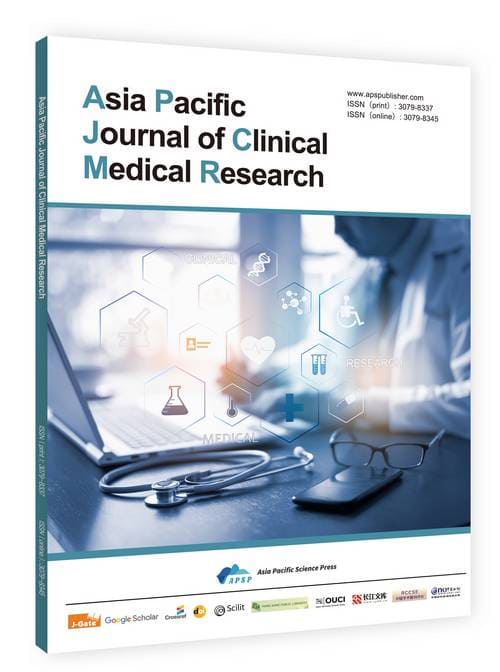Systematic Study on the Mechanism of Tanshinone IIA Based on Bioinformatics
DOI:
https://doi.org/10.62177/apjcmr.v1i2.387Keywords:
Salvia Miltiorrhiza, Tanshinone IIA, Bioinformatics, Mechanism of ActionAbstract
Objective: Tanshinone IIA, one of the most abundant liposoluble components isolated from the traditional Chinese medicine Salvia miltiorrhiza, exhibits significant biological activities in anti-inflammatory, antibacterial, and antitumor effects. This study aims to systematically explore the mechanism of Tanshinone IIA through bioinformatics. Methods: We utilized the TCMSP database to retrieve the oral bioavailability (OB) and drug-likeness (DL) of Tanshinone IIA. The gene chip numbered GSE85871 was downloaded from the GEO database, and differential genes were analyzed using R language to identify potential targets of Tanshinone IIA. After obtaining these targets, GO analysis and KEGG pathway analysis were performed using the DAVID 6.8 database. Diseases related to Tanshinone IIA were explored through the CTD database. Finally, Cytoscape was employed to construct a visual network of multiple targets, pathways, and diseases associated with Tanshinone IIA. Results: Tanshinone IIA demonstrated good drug efficacy with an OB value of 49.89% and a DL value of 0.4. A total of 132 potential targets were identified, primarily exhibiting gene co-expression and physical interaction in the PPI network. These targets were enriched in biological processes and pathways such as ovarian steroidogenesis, cell cycle, and steroid hormone biosynthesis. Tanshinone IIA was found to be relevant in the treatment of diseases including breast tumors, hypertension, atherosclerosis, gliomas, vascular system injuries, left ventricular hypertrophy, leukemia, and hearing loss. Conclusion: Utilizing bioinformatics approaches, we systematically analyzed the possible molecular mechanisms of Tanshinone IIA, providing potential targets and insights into its pharmacological mechanisms and treatment strategies
Downloads
References
Kang, Y., & Gao, M. (2019). Current status and progress in mechanistic studies of Salvia miltiorrhiza in the treatment of coronary heart disease. Liaoning Medical Journal, 33(2), 85–88.
Su, M., Qin, Y., Lou, Y., et al. (2019). Study on the angiogenic effect of sodium tanshinone IIA sulfonate in vitro and in vivo. Drugs & Clinic, 34(4), 934–940.
Ning, J., He, C., & Huang, J. (2019). Study on the anti-inflammatory effect of tanshinone IIA in vitro and in vivo. Drugs & Clinic, 34(2), 292–298.
Tian, Q. (2018). Meta-analysis of tanshinone IIA as adjunctive therapy for chronic heart failure [Master’s thesis, Nanchang University].
Ru, J., Peng, L., Wang, J., et al. (2014). TCMSP: A database of systems pharmacology for drug discovery from herbal medicines. Journal of Cheminformatics, 6(1), 13.
Xu, X., Zhang, W., Huang, C., et al. (2012). A novel chemometric method for the prediction of human oral bioavailability. International Journal of Molecular Sciences, 13(6), 6964–6982.
Mostafavi, S., Ray, D., Wardefarley, D., et al. (2008). GeneMANIA: A real-time multiple association network integration algorithm for predicting gene function. Genome Biology, 9(Suppl 1), 1–15.
Huang, D. W., Sherman, B. T., & Lempicki, R. A. (2009). Systematic and integrative analysis of large gene lists using DAVID bioinformatics resources. Nature Protocols.
Davis, A. P., King, B. L., Mockus, S., et al. (2013). The Comparative Toxicogenomics Database: Update 2011. Nucleic Acids Research, 41(Database issue), D1104–D1114.
Lipinski, C. A., Lombardo, F., Dominy, B. W., et al. (2012). Experimental and computational approaches to estimate solubility and permeability in drug discovery and development settings. Advanced Drug Delivery Reviews, 64(1–3), 4–17.
Van De Waterbeemd, H., & Gifford, E. (2003). ADMET in silico modelling: Towards prediction paradise? Nature Reviews Drug Discovery, 2(3), 192–204.
Xu, W., Yang, J., & Wu, L.-M. (2009). Cardioprotective effects of tanshinone IIA on myocardial ischemia injury in rats. Die Pharmazie, 64(5), 332.
Zhou, L., Liu, Y., Wang, F., et al. (2013). Effects of tanshinone IIA on the activity of NF-κB and IκB in the brain tissue of I/R rats. Chinese Medicinal Materials, 36(7), 1136–1139.
Wang, Y., Liu, X., Zhou, L., et al. (2013). Inhibitory effect of tanshinone IIA on angiogenesis in nude mice with human intestinal cancer. Chinese Journal of Experimental Traditional Medical Formulae, 19(3), 167–171.
Downloads
How to Cite
Issue
Section
License
Copyright (c) 2025 Xing Gao, Xuehui Wang, Yihui Li, Hailing Ding, Keming Li, Shaoyang Hou, Xinchao Wang, Zhaobin Fan

This work is licensed under a Creative Commons Attribution-NonCommercial 4.0 International License.
DATE
Accepted: 2025-05-26
Published: 2025-06-12
















